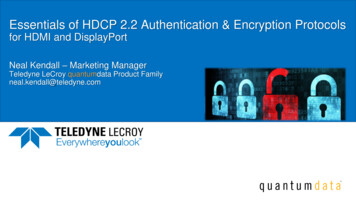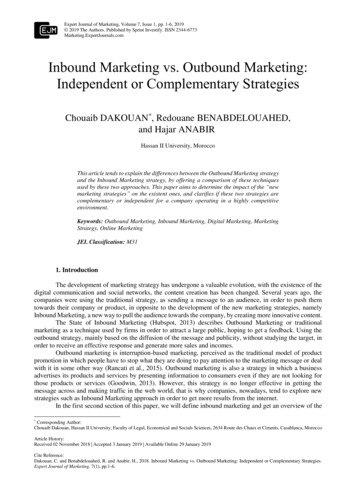
Transcription
Essentials of HDCP 2.2 Authentication & Encryption Protocolsfor HDMI and DisplayPortNeal Kendall – Marketing ManagerTeledyne LeCroy quantumdata Product Familyneal.kendall@teledyne.com
HDCP 2.2 Webinar Agenda What is HDCP 2.2?Overview of Modern CryptographyHDCP 2.2 Authentication & KeyExchange, Pairing, Locality CheckHDCP 2.2 EncryptionHDCP 2.2 Compliance Testing Please Check out our other “Essentials of”Webinars: Essentials of DisplayPort ProtocolsEssentials of HDCP 2.2 ProtocolsEssentials of HDMI Fixed Rate Link (FRL)ProtocolsEssentials of DisplayPort Display Stream(DSC) Protocols
HDCP Overview
Why HDCP? Remember the old days when you could copy movies on a VCR through ananalog video interface cable?
What is HDCP? High-Bandwidth Digital Content Protection (HDCP) - A form of digital copy protection or“Digital Rights Management.”Developed by Intel Corporation in 2003.Licensing governed by Digital Content Protection, LLC (DCP).From DCP website:“Digital Content Protection LLC (DCP) is an organization that licenses technologies for protecting premium commercialentertainment content. High-bandwidth Digital Content Protection (HDCP) is a specification developed by IntelCorporation to protect digital entertainment content across digital interfaces.” Provides a protection mechanism over the physical link, e.g. HDMI and DisplayPort.Control access—modification and distribution--of proprietary copyrighted material, i.e.television and motion picture content.HDCP 2.2 uses modern cryptography mechanisms.
HDCP Interoperability Problems Many people are aware of HDCP only because of interoperability problems while connecting DisplayPort orHDMI or devices.Some experts have said that HDCP is the most difficultthing to get right about HDMI and DisplayPort.
What are the Functions of HDCP? HDCP supports three (3) primary functions: Authentication – A protocol exchange initiated bythe HDCP Transmitter to verify that a Receiver islicensed to receive HDCP content. Encryption – The process by which HDCPencodes protected content such that onlyauthorized devices can use it. Revocation (Renewability) – Is a provision allowingHDCP to revoke the license of a receiver based onnon-compliant behavior.
Basic HDCP 2.2 System - HDMI HDCP Transaction Channel - DDCTMDS Channel 0 (R V/H sync)TMDS Channel 1 (G Control)TMDS Channel 2 (B Control)TMDS Clock ChannelDisplay Data Channel (DDC)CEC BusUtility Line/ 5VUHD SourceHot Plug Detect LineUHD TV
DisplayPort HDCP 2.2 Transaction Channel – Aux ChannelMain Link Lane0Main Link Lane1Main Link Lane2PC LaptopMain Link Lane3Aux ChannelHot Plug – Interrupt RequestComputer Monitor
HDCP System with Distribution DeviceUHD TVsUHD SourceDistribution Amp.
Why HDCP 2.2? HDCP 1.x had some vulnerabilities.HDCP 2.2, not a continuation of HDCP 1.x.Robust, standards based link protectionscheme. RSA cryptography for key exchange duringfor authentication. Advanced Encryption Standard (AES) forencryption.New features: “Pairing” to expedite authentication onsubsequent authentications. “Locality Check” to ensure the receiver isrelatively close.
Overview of Modern Cryptography
Cryptography Definition: Cryptography is the practice and study of techniques for securingcommunication in the presence of third party adversaries.Cryptographic functions include: Hashing Random Number Generation Encryption Digital Certificates and Digital Signatures
Cryptography Modern cryptography uses mathematicalalgorithms to transform information.There are three primitives to achieve this: Substitution – Change the characters in a message. Transposition – Rearrange the characters in amessage. Bitwise operation – XOR, AND, NOT, OR.Note: These processes are often repeated multipletimes. HDCP uses cryptography to encrypt audio andvideo content.
Types of Modern Cryptography Cryptographic systems can be categories by they keys they use: Symmetric-Key (Private-Key) Encryption. (AES)Asymmetric-Key (Public-Key) Encryption. (RSA)Asymmetric (Public) Key Encryption (RSA)Symmetric (Private) Key Encryption (AES)
Types of Cryptography - Symmetric (Private) Key Encryption (AES) Definition: A Cryptographic process using a shared, secret, private key for encrypting &decrypting information between two parties.The commonly used Data Encryption Standard (DES) and the newer, more robust AdvancedEncryption Standard (AES) (used in HDCP 2.2) are forms of symmetrical block ciphertechniques.Symmetric Key encryption is much faster than Asymmetric Key encryption.Used primarily when have to store data in a single place “data at rest.”Examples are: storing data in a database and storing credit card numbers, passwords, etc.Main drawbacks: Secret key needs to be stored securely. Requires a pre-agreed upon secret key, or a secure channel to exchange the secret key. Requires separate keys for each authenticationparty. There is an explosion in the number ofkeys required.Note: In Consumer Electronic devices there is a needto exchange information with non-familiar devices
Cryptography – Asymmetric (Public) Key Encryption (RSA) A cryptographic system that uses pairs of keys: a Public Key which may be disseminatedwidely, and a Private Key which is known only to the owner—e.g. The Receiver.Invented to address the need for exchanging a secret key over an unsecured link.Used when there are separate device endpoints,e.g. web browsers, VPNs, secure shell, secure FTP.RSA is one of the first Asymmetric Key encryptionsystems and is widely used and used in HDCP 2.2.Because of the computational complexity ofAsymmetric Key encryption, it is very slow.Used only for small blocks of data.Many modern systems are a hybrid betweensymmetric and asymmetric key encryption.Often used to transfer a key that will be used forsymmetric key encryption (e.g. “Master Key” inHDCP 2.2).
CryptographyHash Functions
Cryptographic Hash Functions – What Are They? Definition: A cryptographic hash function is a mathematical algorithm that can be used to mapdata of arbitrary size to data of a fixed size.They have been described as the “work horses” of modern cryptography.Cryptographic hash functions are said to be “one-way functions” because they cannot easily bereversed. The only way to recreate the input data (“message”) from an ideal cryptographic hashfunction's output (“Digest”) is to attempt abrute-force search of possible inputs.MessageDigestWikipedia: “SHA-2 is a set of cryptographichash functions designed by the NationalSecurity Agency (NSA).”SHA-256 is a common type of Secure HashAlgorithm. Used extensively in HDCP 2.2. Produces a “Digest” of 256 bits regardlessof the size of the message input.
Cryptographic Hash Functions – What Are They? The ideal cryptographic hash function has five (5) main properties:A small change to a message should change the hash value so extensively that the new hash valueappears uncorrelated with the old hash value. It is deterministic so the same message always results in the same hash digest. It is quick to compute the hash value for any message. It is infeasible to generate a message from its hashvalue (“Digest”) except by trying all possible messages. It is infeasible to find two different messages withthe same hash value “collision resistance.”Note: “Collision resistance” does not mean that nocollisions exist; simply that they are hard to find.(Every hash function with more inputs than outputswill necessarily have collisions.) In HDCP 2.2 SHA-256 Hash is used for: Verifying the Receiver’s Certificate.Verifying that the Receiver properly decrypted theMaster Key (Km).Verifying the Locality Check.Storing the Master Key for Pairing.
Hash Function ApplicationMessageMessageHash GenerationHMAC-SHA-256KeyHash GenerationHMAC-SHA-256HHash OK?H H-PrimeH-PrimeTransmitterReceiverKey
Cryptographic Hash Functions – How Do They Work? Hash FunctionMixing functions use bitwise operationssuch as AND, XOR, NOT, OR, Rotate.Hash FunctionMessageBrokenUp Into NBit Blockse.g. 256 bitsMessage(converted toa binarynumber)Initial HashValue N Bitse.g. a 256Bit KeyMixing algorithmsMIXMIXMIXMIXMIXMIXMIXMIXMIXDigest(Hash)
CryptographyRandom Number Generation
Cryptographic Random Number Generation Types of Random Number Generators:True Random Number Generators – Use natural source of randomness such as thermal noise,network statistics, error counter information, etc. Pseudo-Random Number Generators – Use initial randomly generated seed value. Usesdeterministic algorithms.Measure of randomness is “Entropy”: Entropy is the degree of randomness or the extent to which all possible outcomes are equallylikely. When entropy is high, it is infeasible to predict an output better than pure random chance.Dice throws and coin flips offer a high degree of entropy. You can’t infer the entropy from single instance of a “random” bit stream sample. You can onlydetermine the level of entropy from knowing the process itself or empirically through a vast set oftrials.
Cryptographic Random Number Generation HDCP 2.2 specifies randomness in generating numbers interms of two levels of Entropy: For generating R-Tx, R-Rx, Riv, Rn – Use pseudo-randomgeneration with a minimum entropy of 40 random bits outof 64-bits.For generating Master Key (Km) and Session Key (Ks) –Use true random number generator or a pseudo randomnumber generator with a true random number seed(cryptographically secure pseudo random numbergenerator) with minimum entropy of 128 random bits out ofthe 128 bits. This means that the 128 bit Master andSession Keys would have to be true random numbers.HDCP recommends NIST SP 800-90 standard for randomnumber generator.
CryptographyAES Encryption
AES Encryption AES is a Symmetric (Private) Key encryption mechanism. It uses a single shared private key.AES is a “block cipher” meaning that it operates on small blocks of data at a time.AES has five (5) different modes that it can be operated in. HDCP uses Counter Mode (below).AES is used in HDCP 2.2 for the following functions: Encrypt the Master Key (Km) for storage to facilitate “Pairing.”Encrypting and exchanging the Session Key (Ks).Encrypt the audio/visualCounterCounterinformation.Private KeyAESEncryptionCipher128 BitBlocksUnencryptedContentAESDecryptionCipher128 BitBlocksEncryptedContentXORXORTransmitter ReceiverPrivate KeyUnencryptedContent
AES Encryption – How Does it Work? AES EncryptionCipher 128 BitBlocksUnencryptedContentPrivate Key(e.g. 128 bit“SessionKey”)1Key expansion – uses Rijndael Key Schedule.Substitution – Substituting one “character” of themessage for different “character.” Uses lookup tables.Transposition – Swapping positions of small pieces of themessage. Rows shifted cyclically. Mixing columns.210XORSpawns 128 bit Sub-keys& DistributesSub-KeyXOREncryptedContent
CryptograpyRSA Encryption
RSA Encryption RSA is the most widely used encryption algorithm.RSA is an Asymmetric Key encryption mechanism. It uses a public and a private key.RSA is used when there is a need to exchange small quantities of private information withmultiple parties and when there is no secure channel to exchange a private (shared) keybetween parties.RSA is used in HDCP 2.2 to verify the Receiver’s certificate and to encrypt the Master keybefore it is exchanged with a Receiver.Developed by MIT professors:
RSA Encryption RSA uses the concept of a one-way function; Multiplying 2 primenumbers is easy but reversing the process to find the product’s 2prime numbers (prime factorization) is very difficult.Uses modular arithmetic, or “clock arithmetic.”The n is the product of 2 large prime numbers; it is used as themodulo in the clock arithmetic.Choosing values of e and d is an important factor. Calculationuses what is called a Phi function such that: e * d (mod Phi) 1.First 1024 bits of RxPublic Key are themodulus n;Next 24 bits are e.UnencryptedContent(m)23Mod n 13(e.g. for 17)104 17 congruentw/ 49Receiver’sRSA Private Key(n,d)RSA Cipher(Encrypt)me (modulo n) cRSA Cipher(Decrypt)cd (modulo n) mSender Receiver111Receiver’sRSA Public Key(n,e)Encrypted Content (c)0125876Modular ArithmeticUnencryptedContent (m)
CryptographyDigital Signatures andDigital Certificates
Digital Certificates and Digital Signatures Digital Certificates: A Digital Certificate is electronic information or document that isissued by a trusted third party—a “Certificate Authority” (CA)—thatprovides a way for a sender to verify that a receiver is a trustedparty for private communication.Digital Certificates contain an owner identifier and a public key.Digital Signatures: A Digital Signature is a mechanism or method to verify theauthenticity of a digital message or document (which could be aDigital Certificate).Verifying authenticity means verifying that the message wasgenerated by the assumed sender, i.e. the owner, and that it hasnot been tampered with.Digital Signatures use RSA (public and private keys) and hashingto affect the signature.It is infeasible to re-generate the Digital Signature without theprivate key used in the signature.
Digital Certificates and Digital Signatures In HDCP 2.2, the Trusted Third party is Digital ContentProtection, LLC (DCP) who issues the HDCPReceiver’s certificate.DCP applies a Digital Signature to the HDCPReceiver’s certificate by applying a hash function(Hash-256) and RSA encrypts it with the Receiver’sprivate key.This Digital Signature associates the RSA public key(which is part of the certificate that gets hashed andencrypted) with the Receiver ID, i.e. the owner of theDigital Certificate.
Digital Signatures and Digital Certificates ApplicationDocument(e.g. DigitalCertificate)Hash(TypicallySHA-256)Encryptw/ Receiver’sPrivate Key(Typically RSA)CryptographicSignature ofDocument(e.g. Certificate)Hash(TypicallySHA-256)Decryptw/ Receiver’sPublic Key(Typically RSA)ReceiverSenderReceiverSignatureOk?
HDCP 2.2 Authentication and Key Exchange
HDCP 2.2 Authentication and Key Exchange SequenceHDCP TransmitterTransactionTransmitter FunctionHDCP ReceiverHot PlugReceiver FunctionSend EDID over Aux ChanInitiate HDCP Authentication – AKE-Init 100msAKE-Send-CertificateVerify Signature onCertificate w/ Kpub-TxGenerate Master Key (Km);Encrypt w/ Kpub-RxVerify integrity of SRMRevocation CheckCompute H-Tx andverify H-Tx w/ H-RxWrite encrypted Km – AKE (No Km) 1secRead H – AKE-Send-H-PrimeRead E-Kh AKE-Send-Pairing-InfoStore m, Km and E-Khw/ Receiver IDSet Watchdog TimerCompute L compare withL-PrimeGenerate Session Key (Ks)Compute E-dkeyDecrypt Km w/ KprivCompute H-Prime w/RxCaps and TxCapsAuthentication and Key Exchange Hot plug asserted from the Receiver. Transmitter reads EDID from Receiver. Initiate Authen. (AKE-Init) – Transmitter sends initiationmessage (AKE-Init) which contains a 64 bit pseudo-randomvalue (R-Tx) and TxCaps parameters. TxCaps parametersare the HDCP capabilities of the transmitter. AKE-Send-Cert – Receiver sends Cert-Rx which contains a64 bit pseudo-random value (R-Rx) and RxCapsparameters in response to Transmitter read. RxCapsparameters are the HDCP capabilities of the receiver.(Must be transmitted within 100 ms of AKE-Init.) Transmitter extracts Receiver ID from Cert-Rx - VerifiesSignature on Cert-Rx using Kpub-Rx (a 1048 bit RSA publickey of a receiver) using the following steps:–Compute E-Kh usingMaster Key (Km)–Initiate Locality Check – LC-Init–– 20ms–Read L-prime – LC-Send-L-PrimeSend SKE E-KsDecrypt Session KeyVerify Ks w/ Edkey– Transmitter generates Km (a 128-bit Master Key). Km is thenencrypted using E-Kpub (a 1024 bit value).Write encrypted Km-AKE – Transmitter sends AKE-Km messageto receiver containing the E-Kpub.Receiver decrypts Km w/ Kpriv-Rx (Receiver private key RSA).Receiver computes H-prime (256-bit) w/ RxCaps & TxCaps.Read H (AKE-Send-H-prime) – Receiver sends AKE-Send-HPrime in response to Transmitter read. H-prime must be within 1Sec from time the Transmitter writes AKE-Km message.Transmitter verifies receiver with revocation list.Transmitter computes H-Tx; compares with H-Rx (H-Prime).
HDCP 2.2 Authentication Pairing, Locality Check, Session Key ExchangeHDCP TransmitterTransactionTransmitter FunctionHDCP ReceiverHot PlugReceiver FunctionSend EDID over Aux ChanPairing Transmitter-Receiver Pairing is performed using thefollowing steps:–Initiate HDCP Authentication – AKE-Init– 100msAKE-Send-CertificateVerify Signature onCertificate w/ Kpub-TxGenerate Master Key (Km);Encrypt w/ Kpub-RxVerify integrity of SRMRevocation CheckCompute H-Tx and verifyH-Tx w/ H-RxWrite encrypted Km – AKE (No Km) 1secRead H – AKE-Send-H-PrimeGenerate Session Key (Ks);Compute E-dkey–––Store m, Km and E-Khw/ Receiver IDCompute L; comparew/ L-PrimeLocality Check Locality Check is performed by Transmitter using thefollowing steps:–Read E-Kh AKE-Send-Pairing-InfoSet Watchdog TimerDecrypt Km w/ KprivCompute H-Prime w/RxCaps and TxCapsCompute E-Kh usingMaster Key (Km)–Transmitter sets a watchdog timer.Initiate Locality Check – Transmitter sends LC-Init to receiver.Receiver computes L-Prime (256 bit value).Read L - Receiver transmits LC-Send-L-Prime in response toTransmitter read.Transmitter computes L and compares w/ L-prime fromreceiver.Session Key Exchange Session Key Exchange involves the following steps:Initiate Locality Check – LC-Init 20ms–Read L-prime – LC-Send-L-Prime–Send SKE E-KsRead E-Kh – AKE-Send-Pairing-Info – Receiver sends E-Khusing encryption of Km in response to Transmitter read.Transmitter stores m, Km and E-Kh with Receiver ID (a 40 bitvalue [20 ones and 20 zeros) that uniquely identifies a licensedreceiver).Decrypt Session KeyVerify Ks w/ Edkey––Transmitter generates a 128-bit pseudo-random Session key(Ks) and a 64-bit pseudo-random number R-iv.Derives/computes 128-bit E-dkey using Ks.Transmitter sends E-dkey to receiver.Receiver derives Ks, verifies that it’s equal to E-dkey received.
HDCP 2.2 Cryptographic SummaryAuthentication & Key ExchangeContent EncryptionGenerate Random No.Pseudo-Random No. GenerationVerify Receiver CertificationHash-256, RSA EncryptionKey DerivationAES EncryptionGenerate Master Key (Km)True-Random No. GenerationEncrypt Master Key (Km)RSA EncryptionVerify Master Key (Km)Hash-256Pairing (store Master Key)AES Encryption, Hash-256Locality CheckHash-256Generate Session Key (Ks)Session Key (Ks) ExchangeTrue-Random No. GenerationAES EncryptionA/V EncryptionAES Encryption
Brief Introduction toAux Channel Protocol Analzyer
Auxiliary Channel Analyzer (ACA) Utility Detail Win’wLog Window The Name oftransaction log file ontop banner.Control buttons are onthe right.Two main panels:––Transaction LogPanelDetail Panel (showsdetails for selectedtransaction)
Auxiliary Channel Analyzer (ACA) Utility Direction ( ) Write Msg Read MsgHDCP transactions can belogged from either a 980module’s Tx port(s) or themodule’s Rx port.HDCP transactions caneither be Reads (“R:”) orWrites (“W:”) or anacknowledgement (“ACK”).The “ “ or “ ” indicate thedirection of transmissionfrom the perspective of themonitoring port. In this casethe monitoring port is the980 Tx. The means amessage going from the 980Tx to the sink DUT.
HDCP AuthenticationVerifying the Receiver Certificate
HDCP 2.2 Sequence – AKE Initiation, Send Random Number and TxCapsHDCP TransmitterTransactionTransmitter FunctionHDCP ReceiverHot PlugReceiver FunctionSend EDID over Aux ChanInitiate HDCP Authentication – AKE-Init 100msAKE-Send-CertificateVerify Signature onCertificate w/ Kpub-TxGenerate Km; Encrypt Kmw/ Kpub-TxVerify integrity of SRMRevocation CheckCompute H-Tx and verifyH-Tx w/ H-RxWrite encrypted Km – AKE No Stored Km) 1secRead H – AKE-Send-H-PrimeRead E-kh AKE-Send-Pairing-InfoStore m, Km and E-Khw/ Receiver IDSet Watchdog TimerCompute L comparew/ L-PrimeGenerate Session KeyCompute E-dkeyDecrypt Km w/ KprivCompute H usingRxCaps & TxCapsCompute E-Khusing KmInitiate Locality Check – LC-Init 20ms Read L-prime – LC-Send-L-PrimeTransmitter initiates Authentication and Key Exchange Send SKE E-KsDecrypt Session KeyVerify Ks w/ Edkey Sends R-Tx (64 bit pseudo-random number) later used in theencryption of the Master Key (Km).Sends TCaps (Transmitter HDCP capabilities [Version]).
HDCP 2.2 Sequence – Transmitter Reads Receiver CertificateHDCP TransmitterTransactionTransmitter FunctionHDCP ReceiverHot PlugReceiver FunctionSend EDID over Aux ChanInitiate HDCP Authentication – AKE-Init 100msAKE-Send-CertificateVerify Signature onCertificate w/ Kpub-TxGenerate Km; Encrypt Kmw/ Kpub-RxVerify integrity of SRMRevocation CheckCompute H-Tx and verifyH-Tx w/ H-RxWrite encrypted Km – AKE No Stored Km) 1secRead H – AKE-Send-H-PrimeRead E-Kh AKE-Send-Pairing-InfoStore m, Km and E-Khw/ Receiver IDSet Watchdog TimerCompute L comparew/ L-PrimeDecrypt Km w/ KprivCompute H usingRxCaps & TxCapsCompute E-Khusing KmInitiate Locality Check – LC-Init 20msRead L-prime – LC-Send-L-Prime Transmitter reads Receiver Certificate. Certificate contains: Generate Session KeyCompute E-dkeySend SKE E-KsEncrypt Session KeyVerify Ks with Edkey Receiver ID – Unique receiver ID; 40 bits: 20 ones & 20 zerosReceiver Public Key – Unique 1040 bit RSA public key (kpubrx).DCP signature – Calculated over all fields in certificate.
HDCP 2.2 – Verifying Signature on Receiver Certificate Transmitter verifies that the Receiver’s certificate is authentic usingHash function.Verifies the integrity of themessage (that it was notaltered).Verifies that the ownersigned the message.Receiver Cert- Receiver ID- Receiver Public KeyHash GenerationSHA-256HHash GenerationSHA-256ReceiverSignatureOk?Rx Private KeyRSA EncryptionH’CryptographicSignature ofCertificateRSA DecryptionTx Public KeyTransmitter Receiver
HDCP AuthenticationGenerating, Exchanging the Master Key
HDCP 2.2 Sequence – Transmitter Sends Encrypted Master Key to ReceiverHDCP TransmitterTransactionTransmitter FunctionHDCP ReceiverHot PlugReceiver FunctionSend EDID over Aux ChanInitiate HDCP Authentication – AKE-Init 100msAKE-Send-CertificateVerify Signature onCertificate w/ Kpub-TxGenerate Master Key (Km) Write encrypted Km – AKE No Stored Km)Encrypt w/ Kpub-RxDecrypt Km w/ KprivVerify integrity of SRMCompute H-Prime w/ 1secRevocation CheckRxCaps & TxCapsRead H – AKE-Send-H-PrimeCompute H-Tx and verifyH-Tx w/ H-RxRead E-Kh AKE-Send-Pairing-InfoStore m, Km and E-Kh w/Receiver IDSet Watchdog TimerCompute E-Khusing KmInitiate Locality Check – LC-Init 20msCompute L; Comparew/ L-Prime Read L-prime – LC-Send-L-PrimeGenerate Session Key Send SKE E-KsCompute E-dkeyDecrypt Session KeyVerify Ks w/ EdkeyTransmitter writes Ekpub Km message with Master Key toReceiver (since there is no stored Master Key [Km]):
HDCP 2.2 – Generating, Encrypting and Exchanging Master Key Master Key (Km) is a 128-bit key produced by the Transmitter’s True-random numbergenerator.Master Key is encrypted with the Receiver’s public key and sent to the Receiver.Master KeyGeneration128-bitTrue-RandomRx PublicKey (Kpub-Rx)Rx PrivateKey (Kpriv)AKE No Stored KmMaster Key (Km)RSA EncryptionCipherTransmitter ReceiverRSA DecryptionCipherMaster Key (Km)
HDCP 2.2 Sequence – Transmitter Reads Receiver H-PrimeHDCP TransmitterTransactionTransmitter FunctionHDCP ReceiverHot PlugReceiver FunctionSend EDID over Aux ChanInitiate HDCP Authentication – AKE-Init 100msAKE-Send-CertificateVerify Signature onCertificate w/ Kpub-TxGenerate Km; Encrypt Kmw/ Kpub-RxVerify integrity of SRMRevocation CheckCompute H-Tx andverify H-Tx w/ H-RxWrite encrypted Km – AKE No Stored Km) 1secRead H – AKE-Send-H-PrimeRead E-Kh AKE-Send-Pairing-InfoStore m, Km and E-Kh w/Receiver IDSet Watchdog TimerCompute L; Comparew/ L-PrimeGenerate Session KeyCompute E-dkeyDecrypt Km w/ KprivCompute H usingRxCaps & TxCapsCompute E-Khusing KmInitiate Locality Check – LC-Init 20msRead L-prime – LC-Send-L-PrimeSend SKE E-Ks Decrypt Session KeyVerifies Ks with EdkeyTransmitter reads Receiver’s H-Prime.This verifies the integrity of the Master Key, i.e. that it wasreceived and decrypted properly.
HDCP 2.2 – Verifying Master Key Exchange & Integrity with H H-Prime Master Key is verified by using it on both the Transmitter and Receiver in a hashfunction to hash a message comprised of RTx, RxCaps and TxCaps.MessageMessage(R-Tx, RxCaps,TxCaps)(R-Tx, RxCaps,TxCaps)Derived Key (Kd)(uses Master Key[Km])Hash GenerationHMAC-SHA-256Hash GenerationHMAC-SHA-256HHash OK?H H-PrimeTimerH-PrimeTransmitterReceiverDerived Key (Kd)(uses Master Key[Km])
HDCP AuthenticationPairing
HDCP 2.2 Sequence – Transmitter Reads Pairing InfoHDCP TransmitterTransactionTransmitter FunctionHDCP ReceiverHot PlugReceiver FunctionSend EDID over Aux ChanInitiate HDCP Authentication – AKE-Init 100msAKE-Send-CertificateVerify Signature onCertificate w/ Kpub-TxGenerate Km; Encrypt Kmw/ Kpub-RxVerify integrity of SRMRevocation CheckCompute H-Tx and verifyH-Tx w/ H-RxWrite encrypted Km – AKE No Stored Km) 1secRead H – AKE-Send-H-PrimeRead E-Kh AKE-Send-Pairing-InfoStore m, Km and E-Khw/ Receiver IDSet Watchdog TimerGenerate Session KeyCompute E-dkeyCompute E-Kh w/Master Key (Km)Initiate Locality Check – LC-Init 20msCompute L; Comparew/ L-PrimeDecrypt Km w/ KprivCompute H usingRxCaps and TxCaps Read L-prime – LC-Send-L-PrimeTransmits Send E-KsDecrypt Session KeyVerify Ks with EdkeyTransmitter reads Receiver’s E-Kh AKE Send Pairing info.
HDCP 2.2 – Master Key Storage for Pairing Master Key (Km) is encrypted by Receiver and sent to Transmitter for storing to supportpairing the next time these two devices authenticate together.Hash GenerationHMAC-SHA-256(Kh)AES EncryptionCipherXORAKE Send Pairing Info E-Kh(Km)TransmitterReceiverRx Private Key(Kpriv)RandomNumbers(Rx & Tx)Master Key(Km)
HDCP AuthenticationLocality Check
HDCP 2.2 Sequence – Transmitter Initiates Locality CheckHDCP TransmitterTransactionTransmitter FunctionHDCP ReceiverHot PlugReceiver FunctionSend EDID over Aux ChanInitiate HDCP Authentication – AKE-Init 100msAKE-Send-CertificateVerify Signature onCertificate w/ Kpub-TxGenerate Km Encrypt Kmw/ Kpub-RxVerify integrity of SRMRevocation CheckCompute H-Tx and verifyH-Tx w/ H-RxWrite encrypted Km – AKE (No Km) 1secRead H – AKE-Send-H-PrimeRead E-Kh AKE-Send-Pairing-InfoStore m, Km and E-Kh w/Receiver IDSet Watchdog TimerCompute L comparew/ L-PrimeGenerate Session KeyCompute E-dkeyDecrypt Km w/ KprivCompute H usingRxCaps & TxCapsCompute E-Khusing KmInitiate Locality Check – LC-Init 20ms Read L-prime – LC-Send-L-Prime Send E-KsDecrypt Session KeyVerify Ks with Edkey Transmitter initiates Locality Check.Transmitter sends a random number (Rn) to the Receiver.Transmitter sets a timer.
HDCP 2.2 Sequence – Transmitter Verifies LocalityHDCP TransmitterTransactionTransmitter FunctionHDCP ReceiverHot PlugReceiver FunctionSend EDID over Aux ChanInitiate HDCP Authentication – AKE-Init 100msVerify Signature onCertificate w/ Kpub-TxGenerate Km Encrypt Kmw/ Kpub-RxVerify integrity of SRMRevocation CheckCompute H-Tx and verifyH-Tx w/ H-RxAKE-Send-CertificateWrite encrypted Km – AKE (No Km)Decrypt Km w/ KprivCompute H usingRead H – AKE-Send-H-Prime RxCaps & TxCaps 1secRead E-Kh AKE-Send-Pairing-InfoStore m, Km and E-Kh w/Receiver IDSet Watchdog TimerInitiate Locality Check – LC-Init 20msCompute L; Comparew/ L-PrimeGenerate Session Key(Ks) Compute E-dkeyCompute E-Khusing KmRead L-prime – LC-Send-L-PrimeSend E-Ks Decrypt Session Key Verify Ks w/ EdkeyTransmitter checks for an L-Prime (256-bit number) bycomparing it to its L value (256-bit number).Verifies that L Prime is return within 20 msec.L and L-Prime are generated from the Rn with Hash SHA-256.
HDCP 2.2 Sequence – Transmitter Verifies LocalityTransmitter ReceiverLC vedKey (Kd)DerivedKey (Kd)Hash GenerationHMAC-SHA-256XORR-RxHash OK?L L-PrimeHash GenerationHMAC-SHA-256R-RxLTimerL-PrimeXORLC Send L-Prime
HDCP Session Key Exchange
HDCP 2.2 Sequence – Session Key Generation and ExchangeHDCP TransmitterTransactionTransmitter FunctionHDCP ReceiverHot PlugReceiver FunctionSend EDID over Aux ChanInitiate HDCP Authentication – AKE-Init 100msAKE-Send-CertificateVerify Signature onCertificate w/ Kpub-TxGenerate Km; Encrypt Kmw/ Kpub-RxVerify integrity of SRMRevocation CheckCompute H-Tx and verifyH-Tx w/ H-RxWrite encrypted Km – AKE No Stored Km) 1secRead H – AKE-Send-H-PrimeRead E-Kh AKE-Send-Pairing-InfoStore m, Km and E-Kh w/Receiver IDSet Watchdog TimerCompute L; Comparew/ L-PrimeDecrypt Km w/ KprivCompute H usingRxCaps & TxCapsCompute E-Khusing KmInitiate Locality Check – LC-Init 20ms Read L-prime – LC-Send-L-PrimeGenerate Session Key (Ks)Compute E-dkey SKE Send E-KsEncrypt Ks Decrypt Session KeyVerify Ks w/ Edkey Transmitter generates random Session Key (Ks).The Session Key is AES-encrypted using Master Key (Km)Transmitter sends Session Key (Km) to Receiver with apseudo-random number (Riv) in SKE E-Ks write message.
HDCP 2.2 – Session Key Generation, Encryption and ExchangeRandom No.Derivedfrom R-TxCounterw/ R-RxRandom No.Derivedfrom R-TxCounterw/ R-RxMaster Key(Km)Master Key(Km)XORRandomNumber (Rn)Generation ofSession Key (Ks)& RandomNo. (Riv)AES DecryptionCipherAES EncryptionCipherD-KeyXORRandomNumber (Rn)D-KeySKE Ekh-KsXORXORTransmitterReceiverUnencryptedSession Key
HDCP 2.2 Encryption
HDCP 2.2 – A/V Content EncryptionRandom No.(Riv)Counterw/ R-RxCounterw/ R-RxRandom No.(Riv)Session Key(Ks)Session Key(Ks)XORAES EncryptionCipherAES DecryptionCipher128-bit LocalConstant (lc)128-bit LocalConstant (lc)UnencryptedA/V Content128 BitBlocksXOREncryptedA/V ContentXORXORTransmitterReceiverUnencryptedA/V Content
HDCP Encryption Status Signaling (HDMI) HDCP Transmitter indicates to the Receiver to begin decrypting of the HDCP protectedincoming stream using the
RSA Encryption RSA is the most widely used encryption algorithm. RSA is an Asymmetric Key encryption mechanism. It uses a public and a private key. RSA is used when there is a need to exchange small quantities of private information with multiple parties and when there is no secure ch











